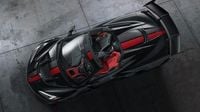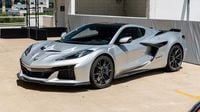General Motors has unveiled the 2026 Chevrolet Corvette ZR1X, a hybrid hypercar that pushes the boundaries of American sports car performance. Revealed in June 2025, the ZR1X combines the raw power of the Corvette ZR1’s twin-turbo 5.5-liter LT7 V-8 engine with an enhanced version of the E-Ray’s hybrid system, resulting in a staggering combined output of 1,250 horsepower. This marks the most powerful Corvette ever produced, and it’s set to hit dealerships by the end of 2025, ushering in a new era for the iconic American marque.
Chevrolet’s Corvette lineup has evolved dramatically since 2019, when the final front-engine model rolled off the assembly line. The current C8 generation introduced a mid-engine layout, shifting the small-block V-8 behind the driver for improved balance and performance. The 2024 Corvette E-Ray broke new ground as the first hybrid and all-wheel-drive Corvette, setting the stage for the ZR1X, which marries the ZR1’s monstrous 1,064-horsepower twin-turbo V-8 with an upgraded electric motor powering the front wheels.
According to Corvette marketing manager Megan Dalley, “It is the most advanced Corvette we've ever produced. America's true hypercar has arrived.” This sentiment reflects the ZR1X’s status as a true hypercar—an elite class above supercars—boasting a top speed of 233 mph and a zero-to-60-mph sprint in under two seconds, figures that push the envelope of what’s possible in a production car.
The ZR1X’s powertrain is a technological marvel. The rear wheels are driven by the LT7 twin-turbocharged V-8, delivering 1,064 horsepower and 828 pound-feet of torque through an eight-speed dual-clutch automatic transmission. Meanwhile, the front axle is powered by a refined electric motor derived from the Corvette E-Ray’s system, now enhanced to produce 186 horsepower and 145 pound-feet of torque. This hybrid setup not only boosts total output but also provides all-wheel-drive capability, improving traction and handling.
Chevrolet engineers increased the usable energy of the ZR1X’s 1.9-kWh battery pack by 29 percent compared to the E-Ray, enabling higher peak operating voltage and sustained power delivery. The front electric motor’s output climbs to 17,000 rpm, up 1,000 rpm from the E-Ray’s 16,000 rpm, allowing the hybrid system to contribute power at speeds up to 160 mph before disengaging. This extended electric assist enhances acceleration and cornering performance.
Performance claims for the ZR1X are jaw-dropping. Chevrolet asserts it can accelerate from zero to 60 mph in less than two seconds and complete the quarter-mile in under nine seconds with a trap speed exceeding 150 mph. Impressively, these feats are reportedly achievable even on unprepared surfaces, hinting at the car’s exceptional traction and control systems.
Chevrolet’s Corvette chief engineer Josh Holder highlights the benefits of the hybrid all-wheel-drive system: “It brings performance, electrification and all-wheel drive to further enhance the unthinkable ZR1. It brings learnings from the ZR1 and the E-Ray, and combines them to create an unbelievable driving experience.” The ZR1X can simultaneously pull 1.0 g of lateral and longitudinal acceleration, a testament to its balanced chassis and advanced traction management.
The ZR1X features a redesigned Performance Traction Management (PTM) Pro mode, which disables traditional traction and stability control while retaining launch control, regenerative brake torque vectoring, and front axle pre-control. Drivers can access various hybrid energy deployment strategies, including Endurance mode for consistent lap performance, Qualifying mode for maximum power on a single lap, and a Push-to-Pass function that unleashes the full 1,250 horsepower via a repurposed steering wheel button.
Braking performance has been substantially upgraded for the ZR1X with the introduction of the J59 brake package, which includes Alcon 10-piston front calipers and six-piston rear calipers clamping onto massive 16.5-inch carbon-ceramic rotors—the largest ever fitted to a Corvette. These brakes are designed to handle the immense kinetic energy generated by the car’s speed, delivering up to 1.9 g of deceleration from 180 to 120 mph, as tested at the Nürburgring. The J59 package will become available on the standard ZR1 starting with the 2026 model year.
Visually, the ZR1X closely resembles the standard ZR1, with subtle differences limited to an “X” badge on the flanks and steering wheel, and a discreet additional front radiator inlet on the driver’s side. Buyers can choose between coupe and convertible body styles, with the coupe featuring a rear split window as a nod to the classic 1963 Corvette. The wide-body rear end includes air intakes for brake and turbo cooling, and aerodynamic elements such as a carbon fiber front splitter, underbody strakes, and a large rear wing are available through the optional ZTK Performance Package.
Inside, the ZR1X benefits from the all-new 2026 Corvette interior design, which addresses longstanding critiques of the C8 cabin. Gone is the “wall” of buttons on the passenger side of the center console, replaced by a grab handle and a streamlined control layout. The cockpit features a 14-inch digital gauge cluster, a 12.7-inch central touchscreen, and a new 6.6-inch auxiliary touchscreen for quick access to head-up display and PTM settings. HVAC controls have been moved below the main screen for improved ergonomics.
Pricing details for the ZR1X have yet to be announced, but industry analysts anticipate a starting price north of $200,000, possibly reaching $275,000 for fully optioned models. This positions the ZR1X as the most expensive Corvette ever, yet it remains a relative bargain compared to its hypercar rivals such as the Ferrari F80 and McLaren W1, which cost multiple millions. Chevrolet’s approach offers hypercar-level performance with a more accessible price tag, expanding the Corvette family to five distinct models—the broadest lineup since the car’s 1953 debut.
General Motors Senior Vice President Ken Morris emphasized the ZR1X’s significance, stating, “From day one, we designed the midengine Corvette architecture with ZR1X in mind. This is the most revolutionary platform in Corvette history.” The vehicle will be produced at GM’s Bowling Green Assembly Plant in Kentucky, continuing the Corvette’s tradition of American manufacturing excellence.
Despite the addition of hybrid technology, the ZR1X maintains the Corvette’s signature driving dynamics. Lead development engineer Keith Badgley noted, “The two powertrains play together in a harmonious and advantageous way that’s beyond what you’d expect from just adding them together.” The electric front axle not only enhances straight-line acceleration but also improves corner exit grip through regenerative brake torque vectoring, delivering a driving experience that’s both thrilling and accessible.
While the hybrid hardware adds approximately 180 to 260 pounds to the car’s weight, engineers have compensated with retuned suspension and aerodynamics to preserve balance and agility. Magnetic Ride Control dampers, Michelin Pilot Sport 4S or Pilot Sport Cup 2R tires, and the Carbon Aero package ensure the ZR1X can hold its own on both road and track.
Chevrolet’s decision to forgo the “Zora” name, long rumored to honor Corvette patriarch Zora Arkus-Duntov, surprised some enthusiasts. However, the automaker insists the ZR1X badge better reflects this model’s role as an evolution of the ZR1 rather than a standalone halo car. Regardless of the name, the ZR1X represents a monumental leap in Corvette performance and technology.
As the automotive world watches, the 2026 Chevrolet Corvette ZR1X is poised to redefine what an American hypercar can be—combining blistering speed, cutting-edge hybrid technology, and everyday usability. With production starting later this year, the ZR1X promises to deliver a driving experience that will thrill enthusiasts and challenge the dominance of far more expensive European supercars.





